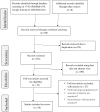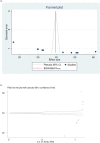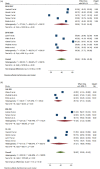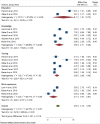Active management of the third stage of labour in Ethiopia: A systematic review and meta-analysis
- PMID: 37079501
- PMCID: PMC10118110
- DOI: 10.1371/journal.pone.0281343
Active management of the third stage of labour in Ethiopia: A systematic review and meta-analysis
Abstract
Background: Post-partum haemorrhage occurs in over 10% of all births and is the leading cause of maternal mortality, accounting for 25% of all maternal deaths worldwide. Active management of the third stage of labor is the most important intervention for reducing maternal morbidity and mortality by preventing postpartum hemorrhage. Previously, documented primary studies had been great discrepancy, inconsistent results, and there is a lack of comprehensive study. Hence, this systematic review and meta-analysis were intended to assess the prevalence and associated factors of the practice of active management of the third stage of labour among obstetric care providers in Ethiopia.
Method: Cross-sectional studies were systematically searched from January 01, 2010, to December 24, 2020, using PubMed, Google Scholar, HINARI, Cochrane Library, and grey literature. The pooled prevalence of active management of the third stage of labour practice and associated factors was estimated using DerSemonial-Laird Random Effect Model. Stata (version 16.0) was used to analyze the data. The I-squared statistic was used to assess the studies' heterogeneity. A funnel plot and Egger's test were used to check for publication bias. A subgroup analysis was performed to minimize the underline heterogeneity depending on the study years and the sample sizes.
Results: Seven hundred fifty articles were extracted. The final ten studies were included in this systematic review, including 2438 participants. The pooled prevalence of practices of active management of the third stage of labour among obstetric care providers in Ethiopia was 39.65% (30.86, 48.45%). Educational status (OR = 6.11, 95%CI, 1.51-10.72), obstetric care training (OR = 3.56, 95% CI: 2.66, 4.45), work experience (OR = 2.17, 95%CI, 0.47, 3.87) and knowledge of active management of the third stage of labour (OR = 4.5, 95% CI: 2.71, 6.28) were significantly associated with active management of the third stage of labour practices.
Conclusion: The practice of active management of the third stage of labour in Ethiopia was low. This study showed that educational status, taking obstetric care training, knowledge of AMTSL, and work experience of obstetric care providers were associated with of practices of active management of the third stage of labour. Therefore, obstetric care professionals should improve their academic level, knowledge, and skills in order to provide useful service to AMTSL and save mothers' lives. All obstetric care providers should get obstetric care training. Furthermore, the government should increase obstetric care professionals' educational level.
Copyright: © 2023 Mihretie et al. This is an open access article distributed under the terms of the Creative Commons Attribution License, which permits unrestricted use, distribution, and reproduction in any medium, provided the original author and source are credited.
Conflict of interest statement
The authors have declared that no competing interests exist.
Figures





Similar articles
-
Magnitude of postpartum hemorrhage and its associated factors in Ethiopia: a systematic review and meta-analysis.Reprod Health. 2022 Mar 9;19(1):63. doi: 10.1186/s12978-022-01360-7. Reprod Health. 2022. PMID: 35264188 Free PMC article.
-
Knowledge and factors associated with active management of the third stage of labor in sub-Saharan Africa: A systematic review and meta-analysis.Int J Gynaecol Obstet. 2024 Sep;166(3):943-953. doi: 10.1002/ijgo.15560. Epub 2024 May 3. Int J Gynaecol Obstet. 2024. PMID: 38700065
-
Nonpneumatic anti-shock garment utilization for obstetric hemorrhage management and its predictors among obstetric care providers in Ethiopia: a systematic review and meta-analysis.BMC Health Serv Res. 2024 Aug 1;24(1):874. doi: 10.1186/s12913-024-11333-0. BMC Health Serv Res. 2024. PMID: 39090626 Free PMC article.
-
Active management of the third stage of labor and associated factors among maternity care providers in public health facilities in Eastern Ethiopia: a multi-center study.BMC Pregnancy Childbirth. 2023 Sep 30;23(1):701. doi: 10.1186/s12884-023-06009-2. BMC Pregnancy Childbirth. 2023. PMID: 37777756 Free PMC article.
-
Obstetric care providers' knowledge, practice and associated factors towards active management of third stage of labor in Sidama Zone, South Ethiopia.BMC Pregnancy Childbirth. 2017 Sep 7;17(1):292. doi: 10.1186/s12884-017-1480-8. BMC Pregnancy Childbirth. 2017. PMID: 28882109 Free PMC article.
Cited by
-
Midwives' experiences with implementation of active management of third stage of labor in Sub-Saharan Africa: a systematic review.BMC Pregnancy Childbirth. 2025 May 8;25(1):547. doi: 10.1186/s12884-025-07331-7. BMC Pregnancy Childbirth. 2025. PMID: 40340625 Free PMC article.
-
Tranexamic acid versus oxytocin prophylaxis in reducing post-partum blood loss, in low-risk pregnant women: TRANOXY STUDY, a phase III randomized clinical trial.EClinicalMedicine. 2024 May 31;73:102665. doi: 10.1016/j.eclinm.2024.102665. eCollection 2024 Jul. EClinicalMedicine. 2024. PMID: 38873634 Free PMC article.
-
Practices and factors associated with active management of the third stage of labor in East Africa: systematic review and meta-analysis.BMC Pregnancy Childbirth. 2023 Jun 13;23(1):438. doi: 10.1186/s12884-023-05761-9. BMC Pregnancy Childbirth. 2023. PMID: 37312067 Free PMC article.
-
Management of Postpartum Hemorrhage in Low- and Middle-Income Countries: Emergency Need for Updated Approach Due to Specific Circumstances, Resources, and Availabilities.J Clin Med. 2024 Dec 4;13(23):7387. doi: 10.3390/jcm13237387. J Clin Med. 2024. PMID: 39685845 Free PMC article. Review.
References
-
- Organization, W.H., WHO recommendations for the prevention and treatment of postpartum haemorrhage. 2012. WHO: Geneva, Switzerland, 2014. - PubMed
-
- Organization, W.H., The World health report: 2005: make every mother and child count. 2005: World Health Organization.
Publication types
MeSH terms
LinkOut - more resources
Full Text Sources

